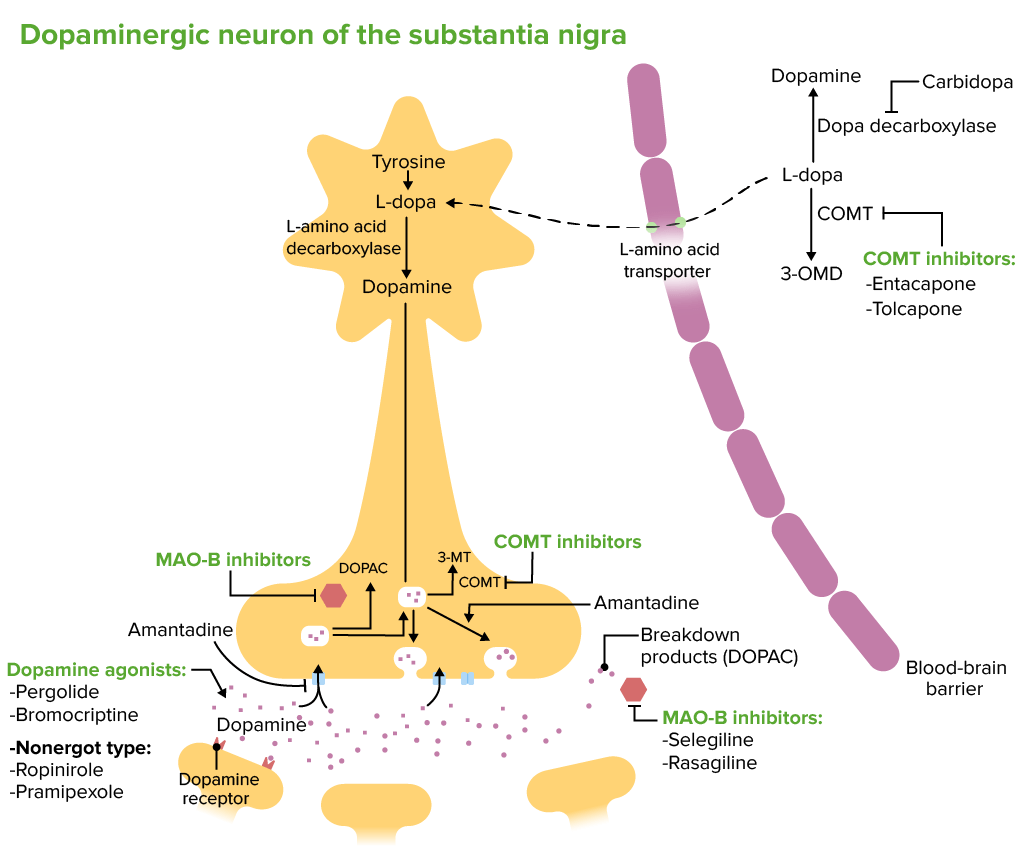Advertisement
Advertisement
Advertisement
Advertisement
Parkinson's disease (PD) is a chronic, progressive neurodegenerative disorder. Although the cause is unknown, several genetic and environmental risk factors are currently being studied. Individuals present clinically with resting tremor Tremor Cyclical movement of a body part that can represent either a physiologic process or a manifestation of disease. Intention or action tremor, a common manifestation of cerebellar diseases, is aggravated by movement. In contrast, resting tremor is maximal when there is no attempt at voluntary movement, and occurs as a relatively frequent manifestation of parkinson disease. Myotonic Dystrophies, bradykinesia, rigidity Rigidity Continuous involuntary sustained muscle contraction which is often a manifestation of basal ganglia diseases. When an affected muscle is passively stretched, the degree of resistance remains constant regardless of the rate at which the muscle is stretched. This feature helps to distinguish rigidity from muscle spasticity. Megacolon, and postural instability. Parkinson disease is diagnosed clinically on the basis of characteristic signs and symptoms. The postmortem finding of Lewy bodies in the brain Brain The part of central nervous system that is contained within the skull (cranium). Arising from the neural tube, the embryonic brain is comprised of three major parts including prosencephalon (the forebrain); mesencephalon (the midbrain); and rhombencephalon (the hindbrain). The developed brain consists of cerebrum; cerebellum; and other structures in the brain stem. Nervous System: Anatomy, Structure, and Classification is the only confirmation for the disease. Treatment includes supportive physical and emotional care plus medications such as levodopa Levodopa The naturally occurring form of dihydroxyphenylalanine and the immediate precursor of dopamine. Unlike dopamine itself, it can be taken orally and crosses the blood-brain barrier. It is rapidly taken up by dopaminergic neurons and converted to dopamine. It is used for the treatment of parkinsonian disorders and is usually given with agents that inhibit its conversion to dopamine outside of the central nervous system. Parkinson’s Disease Drugs/carbidopa, monoamine oxidase Oxidase Neisseria type B inhibitors, and dopamine Dopamine One of the catecholamine neurotransmitters in the brain. It is derived from tyrosine and is the precursor to norepinephrine and epinephrine. Dopamine is a major transmitter in the extrapyramidal system of the brain, and important in regulating movement. Receptors and Neurotransmitters of the CNS agonists.
Last updated: May 17, 2024
Advertisement
Advertisement
Advertisement
Advertisement
Advertisement
Advertisement
Advertisement
Advertisement
Parkinson’s disease (PD) is a chronic, progressive neurodegenerative disorder affecting the CNS with cardinal features of resting tremor Tremor Cyclical movement of a body part that can represent either a physiologic process or a manifestation of disease. Intention or action tremor, a common manifestation of cerebellar diseases, is aggravated by movement. In contrast, resting tremor is maximal when there is no attempt at voluntary movement, and occurs as a relatively frequent manifestation of parkinson disease. Myotonic Dystrophies, rigidity Rigidity Continuous involuntary sustained muscle contraction which is often a manifestation of basal ganglia diseases. When an affected muscle is passively stretched, the degree of resistance remains constant regardless of the rate at which the muscle is stretched. This feature helps to distinguish rigidity from muscle spasticity. Megacolon, bradykinesia, and postural instability.
The etiology of PD is unclear but depends on various genetic and environmental factors.
Compensatory mechanisms in the brain Brain The part of central nervous system that is contained within the skull (cranium). Arising from the neural tube, the embryonic brain is comprised of three major parts including prosencephalon (the forebrain); mesencephalon (the midbrain); and rhombencephalon (the hindbrain). The developed brain consists of cerebrum; cerebellum; and other structures in the brain stem. Nervous System: Anatomy, Structure, and Classification may temporarily decrease the effects of dopamine Dopamine One of the catecholamine neurotransmitters in the brain. It is derived from tyrosine and is the precursor to norepinephrine and epinephrine. Dopamine is a major transmitter in the extrapyramidal system of the brain, and important in regulating movement. Receptors and Neurotransmitters of the CNS depletion until these mechanisms are overpowered by the progression of PD.
The signs of PD are progressive and gradually appear over a long period of years to decades.
The diagnosis of PD is made by clinical history and neurologic examination.
Diagnosis requires 4 things:
Motor Motor Neurons which send impulses peripherally to activate muscles or secretory cells. Nervous System: Histology parkinsonism Parkinsonism West Nile Virus, an essential criterion of PD, requires bradykinesia and at least 1 of the following:
Absolute exclusion criteria (incompatible with a diagnosis of PD):
Supportive criteria:
Red flags (signs of alternative pathology that point toward another diagnosis):
There are no physiologic, radiologic, or blood tests to confirm the clinical diagnosis of PD:
Parkinson disease is confirmed with the finding of Lewy bodies on postmortem analysis.
The goal of management is to treat the symptomatic motor Motor Neurons which send impulses peripherally to activate muscles or secretory cells. Nervous System: Histology and nonmotor features of the disorder to improve quality Quality Activities and programs intended to assure or improve the quality of care in either a defined medical setting or a program. The concept includes the assessment or evaluation of the quality of care; identification of problems or shortcomings in the delivery of care; designing activities to overcome these deficiencies; and follow-up monitoring to ensure effectiveness of corrective steps. Quality Measurement and Improvement of life.
General measures:
Medical therapy:
Deep brain Brain The part of central nervous system that is contained within the skull (cranium). Arising from the neural tube, the embryonic brain is comprised of three major parts including prosencephalon (the forebrain); mesencephalon (the midbrain); and rhombencephalon (the hindbrain). The developed brain consists of cerebrum; cerebellum; and other structures in the brain stem. Nervous System: Anatomy, Structure, and Classification stimulation:

Effects of Parkinson disease treatments on dopaminergic neurons of the substantia nigra
3-OMD: 3-O-methyldopa (a metabolite of l-dopa)
3-MT: 3-methoxytyramine (a metabolite of dopamine)
COMT: catechol O-methyltransferase (a metabolite of dopamine)
DOPAC: 3,4-dihydroxyphenylacetic acid
MAO-B: monoamine oxidase type B